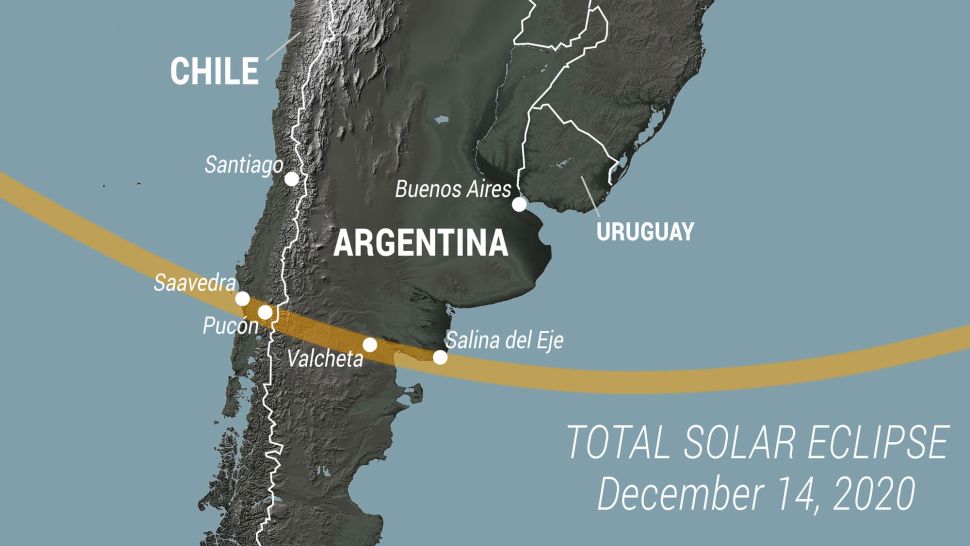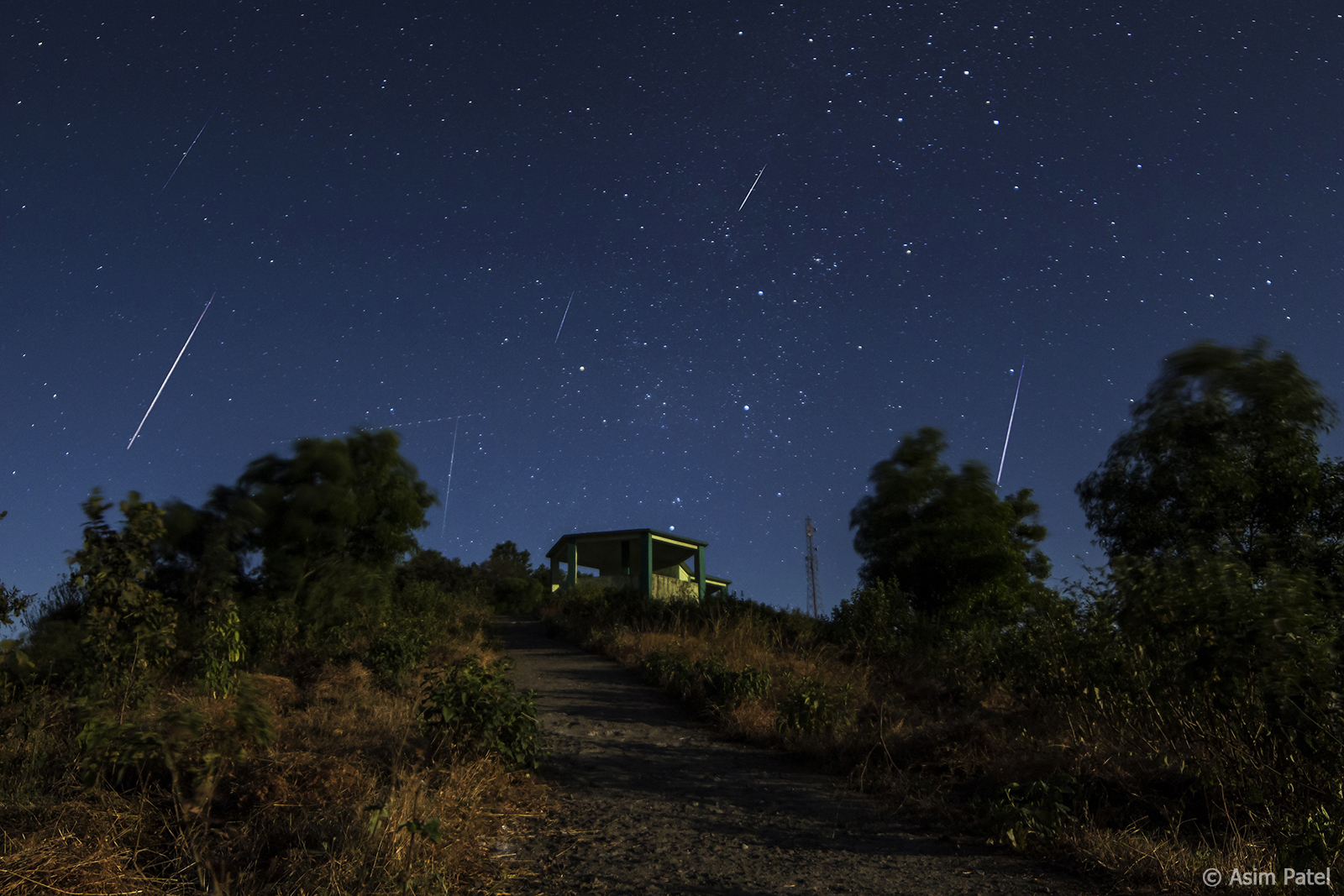2020's Only Total Solar Eclipse Will Be Visible To A Lucky Few In South America
Language
Reading Level
Listen to Article

Total solar eclipses, during which the Sun briefly "disappears" in the daytime, occur about every 18 months. However, unlike lunar eclipses, which can be seen worldwide, the celestial phenomenon can only be observed within a narrow, approximately 100-mile-wide, path of totality. Moreover, total solar eclipses occur at a specific location, on average, about every 360 years. This means that the chance to observe one in real-time is truly rare and special.
The year's only total solar eclipse, which will occur on December 14, 2020, will have a path of totality extending just 56 miles across South America — from Saavedra, Chile to Salina del Eje, Argentina. The continent's other residents and those in Southeastern Africa, including Cape Town, South Africa, will be able to observe a partial solar eclipse. The rest of the world will have to tune in to NASA TV and watch the livestreams from Pontificia Universidad Católica de Chile via telescopes at the Observatorio Docente.

A solar eclipse occurs when the Earth, Moon, and Sun align, with the Moon in the middle. However, we do not experience a total solar eclipse every time this happens because the moon’s elliptical orbit causes its distance from Earth to vary between 221,500 miles to 252,000 miles. For a total eclipse to occur, the Moon has to be at its closest orbital distance (so it appears larger than the Sun), and in perfect line with the Earth and the Sun.
Those able to experience the total eclipse can expect to see surreal darkness creep towards and over them as the satellite positions itself perfectly between the Sun and the Earth. Once the Sun is completely concealed, they will witness a breathtaking sight of its corona, or atmosphere, and bright stars during the middle of the day, albeit for just a few minutes. Fleeting as they are, total solar eclipses provide researchers an opportunity to conduct experiments to solve mysteries such as why the Sun is so hot or the cause of the unpredictable, and often dangerous, solar flames that emanate from its surface.
If you are among the lucky few in the path of this year's solar eclipse — total or partial — be sure to wear special glasses to protect your eyes from the Sun's harmful infrared and ultraviolet radiation, which can result in permanent damage or even blindness.
Geminid Meteor Shower

Those unable to see the solar eclipse can seek out the annual Geminid meteor shower, which will peak the night of Sunday, December 13, through dawn of Monday, December 14, 2020. Called the “900-pound gorilla of meteor showers” by NASA, the shooting stars rank high in both quantity and quality. They are also easier to observe than other meteor showers because they fly across the skies at a noticeably slower pace, encountering Earth at about 22 miles (35 kilometers) per second, or about half the speed of the Perseids meteors’ 37 miles (60 kilometers) per second.
Named after the constellation Gemini, from which they appear to radiate, the Geminids are the result of particles left behind by 3200 Phaethon. The space object, which demonstrates characteristics of both comets and asteroids, orbits the Sun every 1.4 years and comes so close to the star that its surface gets heated to about 1500°F (800°C). This causes it to shed rocky debris the size of sand grains or peas. Over the centuries, the tiny 3200 Phaethon specks have formed a “river of rubble” along its orbit. As Earth traverses through the area every year in mid-December, the particles collide with our planet’s outer atmosphere and burn, transforming into gorgeous “shooting stars.”

For those planning to brave the freezing winter mornings to watch this year’s final celestial show, here are some tips from experts: bundle up, pack some hot cocoa, get as far away as possible from city lights, and, most important of all, be patient. That’s because the shooting stars do not come at regular intervals. Instead, they tend to zip across the skies in clumps, about every five to seven minutes.
Happy Viewing!
Resources: Space.com, Earthsky.com, travelandleisure.com

Get the Workbook for this article!
Workbook contains: Article, Reading Comprehension, Critical Thinking Questions, Vocabulary in Context (+ answers), Multiple Choice Quiz (+ answers), Parts of Speech Quiz (+ answers), Vocabulary Game (+ answers)Cite Article
Learn Keywords in this Article
152 Comments
- athenacat16about 4 yearsI didn't see the eclipse, but the meteor shower was super cool! Me and my family watched it, the stars were all around us.
- denigize-159786085859about 4 yearsit is so so so so so cool
- d57757579about 4 yearsSaturn and jupiter will allign on the winter solstice lets hope it isnt cloudy
- andrewwabout 4 yearsI heard about that
- skilledfox073about 4 yearsAw man. I live in north America. 😥
- yobroyoabout 4 yearsMr too first I thought I missed it I live in Colorado springs
- dodegifo-160623693919about 4 yearssame
- slivermoonabout 4 yearsThat is amazing!
- 12345678901234about 4 yearsthats so cool
- roxanne3about 4 yearsOk guys let me just get really figurative for a second: You know how you can see the corona of the sun during this eclipse, but only for a second?? And in ancient times, people wondered if the sun would ever come back, because they did not have the tools we have today. So imagine this like our corona(virus). We might think that we will only see the corona forever, but it will pass. The sun will always come back!! Stay safe everyone, and if you were able to see the eclipse, tell us about it!! 💜
- saphege_emsalmost 4 yearsthat message is VERY inspiring!
- pasteleaabout 4 yearsSo true
- roxanne3about 4 yearsTHIS IS SO COOL!!! I read an amazing book called Every Soul A Star by Wendy Mass that explained a lot about eclipses and things people will do because of them, but I have never seen a total one like this!! I wish!!
- dragon_of_peaceabout 4 yearsthIs is cool but I can't watch the video 😐
- howlsabout 4 yearsSo cool




